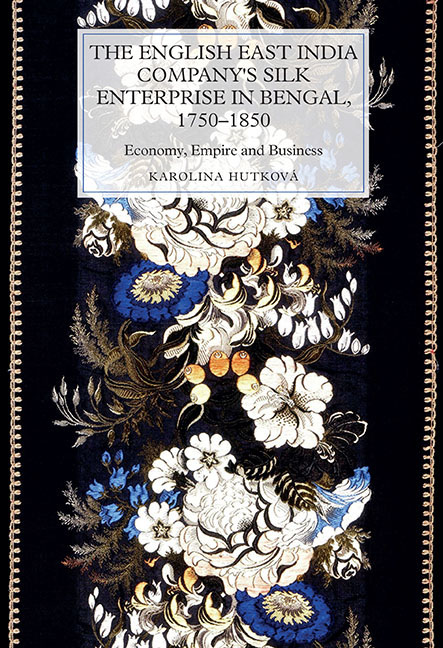Book contents
- Frontmatter
- Contents
- List of Illustrations
- Acknowledgements
- List of Abbreviations
- Measures and Currencies
- Introduction: Companies, Political Economy and the Great Divergenc
- Chapter 1 The Early Modern Silk Industry, Trade and Mercantilism
- Chapter 2 Empire, the English East India Company, and Bengal Raw Silk
- Chapter 3 Bengal, Piedmont and the English East India Company
- Chapter 4 The Bengal Silk Industry and the English East India Company
- Chapter 5 Filatures and Performance in the Bengal Silk Industry
- Chapter 6 The Bengal Silk Industry and British Laissez-Faire Policies
- Chapter 7 Bengal Raw Silk and British Demand in the Nineteenth Century
- Conclusion
- Appendix A Description of the Piedmontese Reeling Machine by Dionysius Lardner
- Appendix B Average Prices of Bengal Raw Silk on the British Market According to the Type of the Silk, 1796–1856
- Appendix C Return on Investment Analysis
- Appendix D Comparison of Manufacturing Costs at the EEIC's Experimental Filature and Common Filature in its Vicinity, 1832
- Appendix E Mechanisation of Silk Throwing and Weaving in England and Scotland, 1856
- Appendix F Types of Silkworm Reared in Bengal Silk Districts, 1818
- Appendix G Glossary
- Bibliography
- Index
- WORLDS OF THE EAST INDIA COMPANY
Chapter 3 - Bengal, Piedmont and the English East India Company
Published online by Cambridge University Press: 31 August 2019
- Frontmatter
- Contents
- List of Illustrations
- Acknowledgements
- List of Abbreviations
- Measures and Currencies
- Introduction: Companies, Political Economy and the Great Divergenc
- Chapter 1 The Early Modern Silk Industry, Trade and Mercantilism
- Chapter 2 Empire, the English East India Company, and Bengal Raw Silk
- Chapter 3 Bengal, Piedmont and the English East India Company
- Chapter 4 The Bengal Silk Industry and the English East India Company
- Chapter 5 Filatures and Performance in the Bengal Silk Industry
- Chapter 6 The Bengal Silk Industry and British Laissez-Faire Policies
- Chapter 7 Bengal Raw Silk and British Demand in the Nineteenth Century
- Conclusion
- Appendix A Description of the Piedmontese Reeling Machine by Dionysius Lardner
- Appendix B Average Prices of Bengal Raw Silk on the British Market According to the Type of the Silk, 1796–1856
- Appendix C Return on Investment Analysis
- Appendix D Comparison of Manufacturing Costs at the EEIC's Experimental Filature and Common Filature in its Vicinity, 1832
- Appendix E Mechanisation of Silk Throwing and Weaving in England and Scotland, 1856
- Appendix F Types of Silkworm Reared in Bengal Silk Districts, 1818
- Appendix G Glossary
- Bibliography
- Index
- WORLDS OF THE EAST INDIA COMPANY
Summary
The silks are not certainly so fine as those of Persia, Syria, Sayd, Bairut, but they are of a much lower price, and I know from indisputable authority that if they were well selected and wrought with care, they might be manufactured into most beautiful stuffs.
So ran Francois Bernier's comments on the silk production of Mughal India in the late seventeenth century. The methods of silk production used in India were not at the forefront of technological innovation but Bernier's view also indicates the potential ascribed to Indian silk production by Europeans. This chapter explores the methods of sericulture and silk reeling used in Bengal before the EEIC started to be directly involved in the region's silk industry. The chapter first considers how Indian raw silk was perceived on the European market and then focuses on the organisation of Bengal silk production, comparing it to that in China and Europe. It shows that the quality of raw silk produced by the Bengalese methods did not match the quality requirements of British silk weavers. The chapter then discusses the initial approach taken by the EEIC to improve quality, and explores the problems in achieving these aims as posed by the system of procurement. Finally, it suggests reasons why the EEIC considered it feasible to increase the quality of raw silk by altering production methods.
Bengal Raw Silk Production in Comparative Perspective
India and China constituted the main industrial areas of the world in premodern times. India attained a pre-eminent position particularly in cotton textile production, a sector in which the subcontinent developed superior knowledge and exceptional productive skills. This chapter asks whether that superior knowledge of production processes also characterised raw silk production. Should the phrase ‘textile factory of the world’ include India's silk industry in the eighteenth century?
Indian cotton production was exported to other regions in Asia as well as to Africa, the Americas and Europe, fostering long-distance trade and conquering global markets. The distinctive aesthetic qualities, designs and colours created a strong international demand for Indian cottons. India's pre-eminent position in the production of cotton textiles in the premodern period was underpinned by its superior knowledge of dyeing and printing, and the precision of its weavers and other textile artisans.
- Type
- Chapter
- Information
- The English East India Company's Silk Enterprise in Bengal, 1750–1850Economy, Empire and Business, pp. 67 - 90Publisher: Boydell & BrewerPrint publication year: 2019



